Yves Saint Laurent (designer)
Yves Henri Donat Mathieu-Saint-Laurent (/ˌiːv ˌsæ̃ lɔːˈrɒ̃/, also UK: /- lɒˈ-/, US: /- loʊˈ-/, French: [iv sɛ̃ lɔʁɑ̃]; 1 August 1936 – 1 June 2008),[1] professionally known as Yves Saint-Laurent, was a French fashion designer who, in 1961, founded his eponymous fashion label. He is regarded as being among the foremost fashion designers in the twentieth century.[2] In 1985, Caroline Rennolds Milbank wrote, "The most consistently celebrated and influential designer of the past twenty-five years, Yves Saint Laurent can be credited with both spurring the couture's rise from its 1960s ashes and with finally rendering ready-to-wear reputable."[3] He was able to adapt his style to accommodate the changes in fashion during that period. He approached fashion in a different perspective by wanting women to look comfortable yet elegant at the same time. He is also credited with having introduced the tuxedo suit for women and was known for his use of non-European cultural references, and non-white models.[4]
Yves Saint-Laurent | |
|---|---|
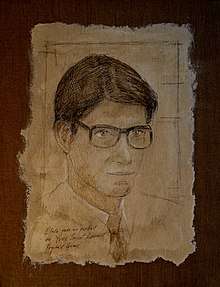 Study of Yves Saint Laurent by Reginald Gray | |
| Born | Yves Henri Donat Mathieu-Saint-Laurent 1 August 1936 |
| Died | 1 June 2008 (aged 71) |
| Nationality | French |
| Education | Chambre Syndicate de la Haute Couture |
| Occupation | Fashion designer |
Label(s) | Yves Saint Laurent |
| Partner(s) | Pierre Bergé |
Early life
Saint Laurent was born on 1 August 1936, in Oran, French Algeria,[5][6] to French parents, Charles and Lucienne Andrée Mathieu-Saint-Laurent.[7] He grew up in a villa by the Mediterranean with his two younger sisters, Michèle and Brigitte.[7] Saint Laurent liked to create intricate paper dolls, and by his early teen years he was designing dresses for his mother and sisters. At the age of 17, Saint Laurent moved to Paris and enrolled at the Chambre Syndicale de la Haute Couture, where his designs quickly gained notice. Michel De Brunhoff, the editor of French Vogue, introduced Saint Laurent to designer Christian Dior, a giant in the fashion world. "Dior fascinated me," Saint Laurent later recalled. "I couldn't speak in front of him. He taught me the basis of my art. Whatever was to happen next, I never forgot the years I spent at his side." Under Dior's tutelage, Saint Laurent's style continued to mature and gain even more notice.[8]
Personal life and career
Young designer
In 1953, Saint Laurent submitted three sketches to a contest for young fashion designers organised by the International Wool Secretariat. Saint Laurent won first place. Subsequently, he was invited to attend the awards ceremony held in Paris in December of that same year. During his stay in Paris, Saint Laurent met Michel de Brunhoff (who was then editor-in-chief of the French edition of Vogue magazine and a connection of his father). De Brunhoff, known by some as a considerate person who encouraged new talent, was impressed by the sketches Saint Laurent brought with him and suggested he become a fashion designer. Saint Laurent would eventually consider a course of study at the Chambre Syndicale de la Haute Couture, the council which regulates the haute couture industry and provides training to its employees. Saint Laurent followed his advice and, leaving Oran for Paris after graduation, began his studies there and eventually graduated as a star pupil. Later that same year, he entered the International Wool Secretariat competition again and won, beating out his friend Fernando Sánchez and young German student Karl Lagerfeld.[9] Shortly after his win, he brought a number of sketches to de Brunhoff who recognized close similarities to sketches he had been shown that morning by Christian Dior. Knowing that Dior had created the sketches that morning and that the young man could not have seen them, de Brunhoff sent him to Dior, who hired him on the spot.
Although Dior recognised his talent immediately, Saint Laurent spent his first year at the House of Dior on mundane tasks, such as decorating the studio and designing accessories. Eventually, however, he was allowed to submit sketches for the couture collection; with every passing season, more of his sketches were accepted by Dior. In August 1957, Dior met with Saint Laurent's mother to tell her that he had chosen Saint Laurent to succeed him as designer. His mother later said that she had been confused by the remark, as Dior was only 52 years old at the time. Both she and her son were surprised when in October of that year Dior died at a health spa in northern Italy of a massive heart attack.[9]
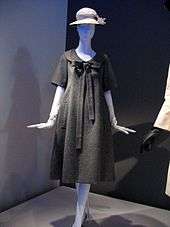
In 1957, Saint Laurent found himself at age 21 the head designer of the House of Dior. His spring 1958 collection almost certainly saved the enterprise from financial ruin; the straight line of his creations, a softer version of Dior's New Look, catapulted him to international stardom with what would later be known as the "trapeze dress". Others included in the collection were dresses with a narrow shoulder and flared gently at the bottom. At this time, he shortened his surname to Saint Laurent because the international press found his hyphenated triple name difficult to spell.
His fall 1958 collection was not greeted with the same level of approval as his first collection, and later collections for the House of Dior featuring hobble skirts and beatnik fashions were savaged by the press.
In 1959, he was chosen by Farah Diba, who was a student in Paris, to design her wedding dress for her marriage to the Shah of Iran.[10]
In 1960, Saint Laurent found himself conscripted to serve in the French Army during the Algerian War of Independence. Alice Rawsthorn writes that there was speculation at the time that Marcel Boussac, the owner of the House of Dior and a powerful press baron, had put pressure on the government not to conscript Saint Laurent in 1958 and 1959, but after the disastrous 1958 season, reversed course and asked that the designer be conscripted so that he could be replaced.
Conscription, illness and independence
.jpg)
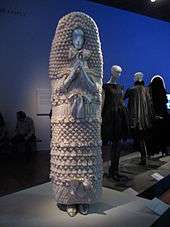
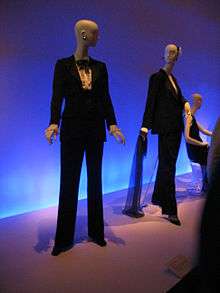
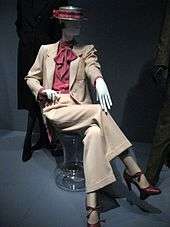
Saint Laurent was in the military for 20 days before the stress of hazing by fellow soldiers led to him being admitted to a military hospital, where he received news that he had been fired from Dior. This exacerbated his condition, and he was transferred to Val-de-Grâce military hospital, where he was given large doses of sedatives and psychoactive drugs, and subjected to electroshock therapy.[11] Saint Laurent himself traced the origin of both his mental problems and his drug addictions to this time in hospital.[9]
After his release from the hospital in November 1960, Saint Laurent sued Dior for breach of contract and won. After a period of convalescence, he and his partner, industrialist Pierre Bergé, started their own fashion house Yves Saint Laurent YSL with funds from American millionaire J. Mack Robinson.[12] The couple split romantically in 1976 but remained business partners.[13]
In the 1960s and 1970s, the firm popularised fashion trends such as the beatnik look; safari jackets for men and women; tight trousers; tall, thigh-high boots; and arguably the most famous classic tuxedo suit for women in 1966, Le Smoking. The 1965 Mondrian collection was particularly renowned. Saint Laurent also started mainstreaming the idea of wearing silhouettes from the 1920s, 1930s and 1940s. Yves Saint Laurent brought in new changes to the fashion industry in the 60s and the 70s. The French designer opened his Pret-a-Porter House YSL Rive Gauche in 1967 where he was starting to shift his focus from Haute Couture to Ready-to-wear. One of the purpose was to provide a wider range of fashionable style being available to choose from in the market as they were affordable and cheaper.
He was the first French couturier to come out with a full prêt-à-porter (ready-to-wear) line, although Alicia Drake credits this move with Saint Laurent's wish to democratize fashion;[14] others point out that other couture houses were preparing prêt-à-porter lines at the same time – the House of Yves Saint Laurent merely announced its line first. The first of the company's Rive Gauche stores, which sold the prêt-à-porter line, opened on the rue de Tournon in the 6th arrondissement of Paris, on 26 September 1966. The first customer was Catherine Deneuve.[9] He ended up doing many costumes for her in films such as Heartbeat, Mississippi Mermaid, and Love to Eternity.[15]
Many of his collections were positively received by both his fans and the press, such as the autumn 1965 collection, which introduced Le Smoking tailored tuxedo suit. Other collections raised controversy, such as his spring 1971 collection, which was inspired by 1940s fashion. Some felt it romanticized the German occupation of France during World War II, which he did not experience, while others felt it brought back the unattractive utilitarianism of the time. The French newspaper France Soir called the spring 1971 collection "Une grande farce!"[9]
During the 1960s and 1970s, Saint Laurent was considered one of Paris's "jet set".[14] He was often seen at clubs in France and New York City, such as Regine's and Studio 54, and was known to be both a heavy drinker and a frequent user of cocaine.[9] When he was not actively supervising the preparation of a collection, he spent time at his villa in Marrakech, Morocco. In the late 1970s, he and Bergé bought a neo-gothic villa, Château Gabriel in Benerville-sur-Mer, near Deauville, France. Yves Saint Laurent was a great admirer of Marcel Proust who had been a frequent guest of Gaston Gallimard, one of the previous owners of the villa. When they bought Château Gabriel, Saint Laurent and Bergé commissioned Jacques Grange to decorate it with themes inspired by Proust's Remembrance of Things Past.[16]
The prêt-à-porter line became extremely popular with the public if not with the critics and eventually earned many times more for Saint Laurent and Bergé than the haute couture line. However, Saint Laurent, whose health had been precarious for years, became erratic under the pressure of designing two haute couture and two prêt-à-porter collections every year. He increasingly turned to alcohol and drugs. At some shows, he could barely walk down the runway at the end of the show, and he had to be supported by models.
After a disastrous 1987 prêt-à-porter show in New York City, which featured US$100,000 jeweled casual jackets only days after the "Black Monday" stock market crash, he turned over the responsibility of the prêt-à-porter line to his assistants. Although the line remained popular with his fans, it was soon dismissed as "boring" by the press.[9]
Later life
In 1983, Saint Laurent became the first living fashion designer to be honoured by the Metropolitan Museum of Art with a solo exhibition. In 2001, he was awarded the rank of Commander of the Légion d'Honneur by French president Jacques Chirac. Saint Laurent retired in 2002 and became increasingly reclusive, living at his homes in Normandy and Morocco with his pet French Bulldog Moujik.
He also created a foundation with Bergé in Paris to trace the history of the house of YSL, complete with 15,000 objects and 5,000 pieces of clothing.
A favourite among his female clientele, Saint Laurent had numerous muses that inspired his work. Chief among these was Victoire Doutreleau along with Mounia – his oft used "bride" and 'Porgy and Bess' thematic couture-garment model and frequent YSL cover-model in Women's Wear Daily and French Vogue. Among his other muses were Loulou de la Falaise, the daughter of a French marquis and an Anglo-Irish fashion model; Somali supermodel Iman, whom he once described as his "dream woman";[17] Betty Catroux, the half-Brazilian daughter of an American diplomat and wife of a French decorator; French actress Catherine Deneuve; Dutch actress Talitha Pol-Getty; Nicole Dorier, a YSL top model in 1978–83, who became one of his assistants in organizing his runway shows and, later, the "memory" of his house when it became a museum; Guinean-born Senegalese supermodel Katoucha Niane; Togolese-born supermodel Rebecca Ayoko and supermodel Laetitia Casta, who was the bride in his shows in 1997–2002.
In 2007, he was awarded the rank of Grand officier de la Légion d'honneur by French President Nicolas Sarkozy.[18][19]
Death
Saint Laurent died on 1 June 2008, of brain cancer at his residence in Paris.[20] According to The New York Times,[21] a few days prior, he and Bergé had been joined in a same-sex civil union known as a Pacte civil de solidarité (PACS) in France. When Saint Laurent was diagnosed as terminal, with only one or two weeks left to live, Bergé and the doctor mutually decided that it would be better for him not to know of his impending death. Bergé said, "I have the belief that Yves would not have been strong enough to accept that."[22]
He was given a Catholic funeral at Église Saint-Roch in Paris.[23] The funeral attendees included former queen of Iran Farah Pahlavi, Bernadette Chirac, Catherine Deneuve, and President Nicolas Sarkozy and his wife Carla Bruni.[24]
His body was cremated and his ashes were scattered in Marrakech, Morocco, in the Majorelle Garden, a residence and botanical garden that he owned with Bergé since 1980 and often visited to find inspiration and refuge.[25] Bergé said at the funeral service: "But I also know that I will never forget what I owe you and that one day I will join you under the Moroccan palms" (translated from the French).
Legacy
In February 2009, an auction of 733 items was held by Christie's at the Grand Palais, ranging from paintings by Picasso to ancient Egyptian sculptures. Saint Laurent and Bergé began collecting art in the 1950s; before the sale, Bergé commented that the decision to sell the collection was taken because, without Saint Laurent, "it has lost the greater part of its significance", with the proceeds proposed for the creation of a new foundation for AIDS research.
Before the sale commenced, the Chinese government tried to stop the sale of two of twelve bronze statue heads taken from the Old Summer Palace in China during the Second Opium War. A French judge dismissed the claim and the sculptures, heads of a rabbit and of a rat, sold for €15,745,000.[26] However, the anonymous buyer revealed himself to be Cai Mingchao, a representative of the PRC's National Treasures Fund, and claimed that he would not pay for them on "moral and patriotic grounds".[27] The heads remained in Bergé's possession[28] until acquired by François Pinault, owner of many luxury brands including Yves Saint Laurent. He then donated them to China in a ceremony on 29 June 2013.[29]
On the first day of the sale, Henri Matisse's painting Les coucous, tapis bleu et rose broke the previous world record set in 2007 for a Matisse work and sold for 32 million euro. The record-breaking sale realized 342.5 million euro (£307 million).[30] The subsequent auction, 17–20 November, included 1,185 items from the couple's Normandy villa and while not as impressive as the first auction, featured the designer's last Mercedes-Benz car and his Hermès luggage.[31]
Forbes rated Saint Laurent the top-earning dead celebrity in 2009.[32]
In popular culture
On film
- 2002 – David Teboul's Yves Saint Laurent: His Life and Times
- 2002 – Yves Saint Laurent: 5 Avenue Marceau 75116 Paris
- 2009 – Pierre Thoretton's L'Amour Fou[33]
- 2014 – Yves Saint Laurent[34]
- 2014 – Saint Laurent
Television
Books
- 2014 – Yves Saint Laurent: A Moroccan Passion, Pierre Bergé, illustrated by Lawrence Mynott, Abrams, ISBN 978-1419713491[36]
References
- "Yves Saint Laurent Dies – Yves Saint Laurent Has Died in Paris Aged 71" Archived 3 June 2008 at the Wayback Machine. Agence France-Presse (via Nine News). (2 June 2008). Retrieved 12 June 2010.
- "Yves Saint Laurent, Who Has Died Aged 71, was, with Coco Chanel, regarded as the Greatest Figure in French Fashion in the 20th Century, and could Be Said to have Created the Modern Woman's Wardrobe". The Daily Telegraph. UK. 1 June 2008. Retrieved 24 July 2010.
- "Yves Saint-Laurent". Goodreads. Retrieved 20 May 2012.
- Yves Saint Laurent's body put to rest Archived 29 October 2014 at the Wayback Machine Fashion Television.
- "Yves Saint Laurent". Fondation Pierre Bergé – Yves Saint Laurent. Retrieved 4 November 2014.
- "Yves Saint Laurent". Encyclopædia Britannica. Retrieved 4 November 2014.
- "Yves Saint Laurent Biography". bio. Retrieved 7 June 2015.
- "Yves Saint Laurent".
- Rawsthorn, Alice (1996). Yves Saint Laurent: A Biography. Nan A. Talese/Doubleday (New York City). ISBN 0-385-47645-0.
- "The Royal Order of Sartorial Splendor: Wedding Wednesday: Empress Farah's Gown". 22 February 2012.
- The Biography Channel – Yves Saint Laurent Biography Archived 6 August 2009 at the Wayback Machine
- Torpy, Bill. "Metro Atlanta Business News". ajc.com. Retrieved 15 August 2010.
- Cole, Shaun (2002). "Saint Laurent, Yves". glbtq.com. Archived from the original on 14 August 2007. Retrieved 25 August 2007.
- Drake, Alicia. The Beautiful Fall: Lagerfeld, Saint Laurent, and Glorious Excess in 1970s Paris. Little, Brown and Company, 2006. p.49.
- "Yves Saint-Laurent". IMDb. Retrieved 30 December 2019.
- Grange, Jacques (21 October 2009). "An Introduction to Château Gabriel". Christie's. Retrieved 20 October 2014.
- Beauty Icon: Iman Archived 6 December 2010 at the Wayback Machine
- "Yves Saint Laurent Devient Grand Officier de la Legion D'Honneur !". Marie Claire (in French). 2008. Retrieved 15 July 2016.
- "Obituary: Yves Saint Laurent". The Telegraph. 3 June 2008. Retrieved 15 July 2016.
- "Tributes for Yves Saint Laurent". BBC News. 2 June 2008. Retrieved 2 June 2008.
- France Salutes the Ultimate Couturier New York Times.
- "Pierre Bergé: "Yves Died at the Right Time"". The Talks.
- "Catholic farewell for YSL". CathNews. 6 June 2008. Archived from the original on 24 March 2012. Retrieved 26 January 2012.
- "Empress Farah Pahlavi attends the funeral services of fashion designer Yves Saint Laurent on June 5". Farah Pahlavi website. 5 June 2008. Archived from the original on 3 July 2010. Retrieved 15 August 2010.
- "Yves Saint Laurent's Ashes Scattered In Marrakesh". Reuters. 12 June 2008. Retrieved 24 March 2009.
- "features in upcoming Christie's auctions". Christies.com. Retrieved 15 August 2010.
- "China 'patriot' sabotages auction". BBC News. 2 March 2009. Retrieved 27 March 2010.
- McDonald, Mark; Vogel, Carol (2 March 2009). "Twist in Sale of Relics Has China Winking". The New York Times. New York City.
- "Looted Bronzes Return To China: Animal Heads Were Taken From Beijing Palace In 1860". Huffington Post. 28 June 2013. Retrieved 30 June 2013.
- "Record bids for YSL private art". BBC News. 24 February 2009. Retrieved 27 March 2010.
- "Yves Saint Laurent auction items from Normandy hideaway up for sale". The Telegraph. 10 November 2009. Retrieved 18 May 2011.
- Matthew Miller (27 October 2009). "Top-Earning Dead Celebrities". Forbes.
- Holden, Steven (12 May 2011). "The Passions and Demons of Yves Saint Laurent". The New York Times. New York, New York. p. C12. Retrieved 13 May 2011.
- Diderich, Joelle (10 January 2014). "Yves Saint Laurent Biopic Wins Pierre Bergé's Approval". WWD. Retrieved 10 January 2014.
- "10-25-1965 What's My Line". Retrieved 23 December 2014.
- "Yves Saint Laurent: A Moroccan Passion - Fashion - Abrams & Chronicle". Archived from the original on 2 April 2015. Retrieved 21 March 2015.
Further reading
- Milbank, Caroline Rennolds (1985) Couture – The Great Fashion Designers. Thames & Hudson.
- Bergé, Pierre (1997). Yves Saint Laurent – The Universe of Fashion. Rizzoli. ISBN 0-7893-0067-2.
- Rawsthorn, Alice (1996). Yves Saint Laurent – A Biography. Nan A. Talese/Doubleday. ISBN 0-385-47645-0.
External links
| Wikimedia Commons has media related to Yves Saint Laurent. |
| Wikiquote has quotations related to: Yves Saint Laurent |
- ysl.com, official Yves Saint Laurent (brand) website
- Trapèze dresses at Digital Collections at Chicago History Museum
- The Guardian: retrospective article
- "Interactive timeline of couture houses and couturier biographies". Victoria and Albert Museum.
- Biography of Yves Saint Laurent
- Yves Saint Laurent Biography
- Yves Saint Laurent shuts its doors – BBC World 31 October 2002
- All About Yves – Jim Lehrer 16 January 2002 By Jessica Moore
- Yves Saint Laurent announces retirement – CNN 7 January 2002
- All About Yves: As the incomparable Yves Saint Laurent celebrates his 40th anniversary as a couturier, the world salutes his genius. – Julie K.L. Dam, Time magazine, 3 August 1998.